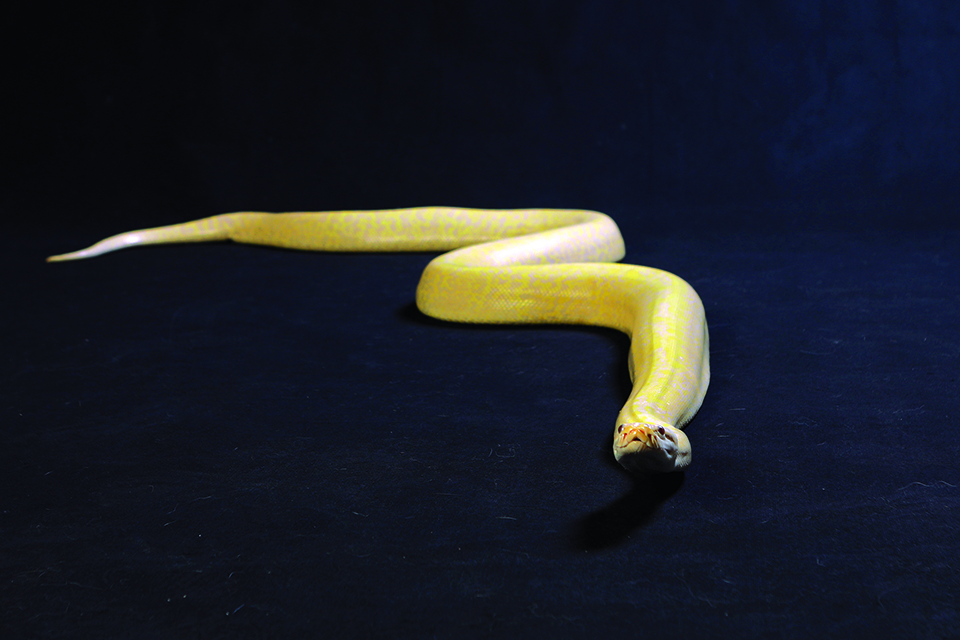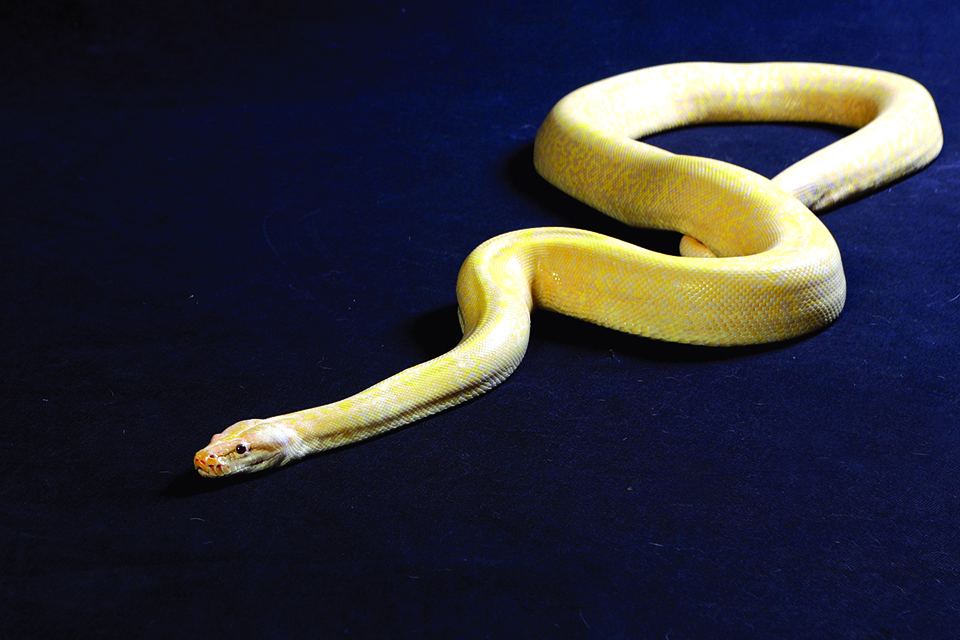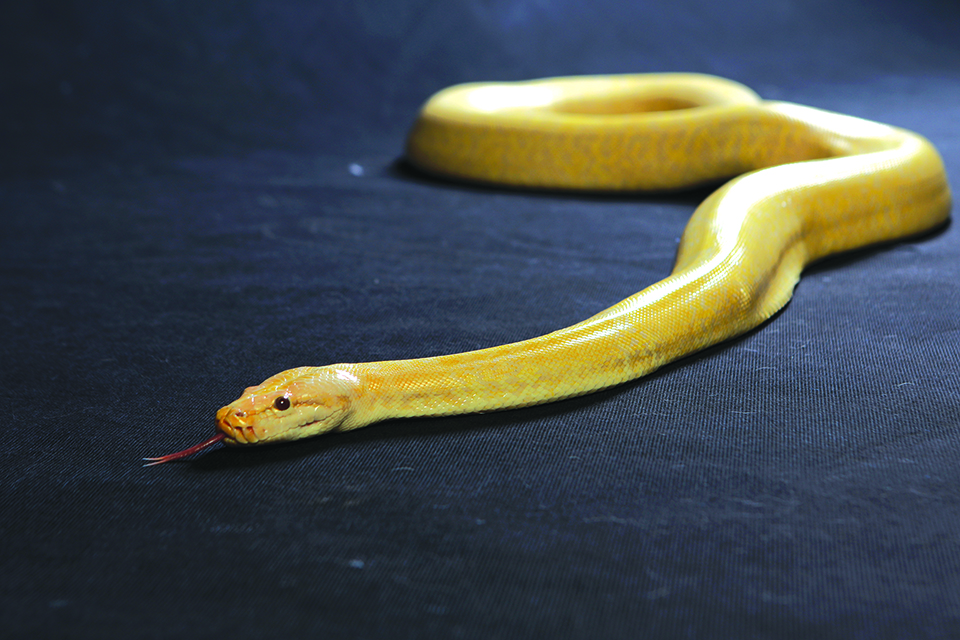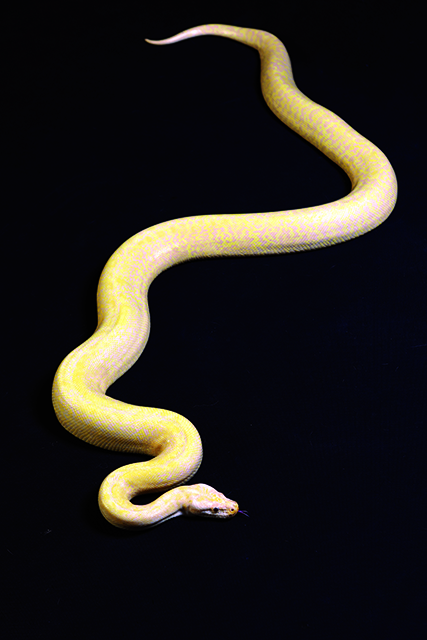LET’S GET TO KNOW THE CARAMEL GRANITE BURMESE PYTHON
Caramel coloration among pythons is a form of albinism. In true albinos or T– animals, there is a total lack of black pigment. With caramels or T+ animals, some dark pigment can be produced, and they change drastically in color from hatchlings to adults.
The babies start out with light brown or caramel blotches on a tan background. As they age, the colors get lighter and brighter. As adults, the whites become extremely bright. The blotches are a light color and usually outlined in purple hues.
This issue’s seductive serpent is the Caramel Granite Burmese Python.
NO TINY SNAKE
Burmese pythons are native to South and Southeast Asia and are one of the five largest species of snakes in the world. These are no tiny starter snakes. They are found in the wild near water or inside trees, and they grow to about an average of 12 feet in length. Exceptional individuals can grow longer than 20 feet and weigh more than 250 pounds.
Because they have simple needs and are relatively tame creatures, Burmese pythons are some of the most suitable of the large snakes to keep. These snakes are available in a variety of colors and patterns, such as caramel granite. Since these serpents originated from tropical climates, they adapt easily to the local climate.
One experienced keeper is Melvin So, who has had many Burmese pythons under his care. “I used to have at least 10 visible Caramel Granite Burmese Pythons under my care,” So explains. “My other Burmese Pythons are gene carriers.”
With so many snakes in his care, does So have a favorite? “I like all of my Burmese Pythons,” he answers. “It’s difficult to choose just one because all of them have different personalities and traits. They are unique in their own ways.”
So, what makes this Caramel Granite Burmese Python special in So’s eyes? “This is a truly amazing animal,” So says fawningly. “Two recessive genes in one snake, since Caramel and Granite are both recessive genes.”

TERMS OF ENDEARMENT
The world of python genetics can be a dizzying whirlwind of jargon, but fortunately, So patiently explained these terms to us.
“Caramel is one form of Albinism and up to this date is still considered rare in any collection. The Granite morph is a beautifully patterned mutation. If [you’ve had enough experience caring for snakes], the moment you see this snake, you would know that this is special. The appearance would speak for itself.”

PROVIDING A HOME
Feeding Burmese Pythons of any color or pattern can be a challenge for someone without much experience, as they feed on a heavy diet of live animals. “They are carnivores – in the wild, they prey on small mammals and birds,” explains So. “In my opinion, baby Burmese Pythons should eat mice in captivity. As they grow, you could increase the number of mice, large rats, or small rabbits. Large snakes can eat a whole chicken, a large rabbit or even a small pig,” he says.
Fortunately, Burmese Pythons are not shrinking violets. “They are hardy animals,” says So, “and can be easily raised.” A single 55-gallon tank works for younger snakes. However, as they grow in size, they will need larger and stronger enclosures.
Custom-built wood and Plexiglass cages or a large closet or room can be good options for a Burmese python. These snakes are well-known for being escape artists and are quite strong. This is why their housing must be substantial — at least 8 feet long, 4 feet wide, and 4 feet tall, strong, and very secure.
For younger snakes, a half log or other hide will work, but as they grow, you will have to be more creative. Plastic storage bins make good hides for larger snakes.
WATER WEIGHT
Burmese pythons also need a large and sturdy water container. Younger snakes can drink out of a heavy dog water bowl. Adults will need a larger container. If you use plastic containers, remember that these are light and can easily tip over, so weigh them down with rocks or other heavy objects.

CARE TIPS
DO SPOT-CLEANING
Spot-clean the bedding or floor of the enclosure whenever they defecate.
PROVIDE CLEAN WATER
Change the water and clean out the container daily.
CLEAN ENCLOSURES MONTHLY
Every month, clean the entire enclosure. Disinfect the enclosure and change out the bedding.
PROBLEM SOLVING
What are some of the issues one might face when raising a Burmese python? We asked So what problems to look out for.

WEIGHT ISSUES
“I’ve noticed that the problems raising this species in captivity are, first, obesity. They are good eaters; some keepers feed them multiple times a week – this is not ideal. And if you keep your Burmese Python in a small enclosure, lack of exercise would also lead to obesity.”
A sizable enclosure should remedy this problem.
RESPIRATORY INFECTION
“Second,” says So, “is respiratory infection. They are cold blooded animals that depend on heat to digest their food. In the wild, they would bask in the sun. In captivity, I noticed a lot of keepers do not put any heating lamp or pads during the cold season that leads to respiratory problems.”
Even though we live in a tropical climate, do not forget to give your Burmese python adequate heating.
SUBSTRATE SELECTION
“Clean substrate and water should always be applied,” says So. (Substrate is the term for the bedding or lining used at the bottom of a snake’s enclosure.)
For hatchlings, use paper towels or unprinted paper as substrate to line the enclosure. For bigger snakes, indoor/outdoor carpeting is easier to maintain; keep a few pieces on hand and switch them out when it is time to clean and disinfect. You can also cut linoleum sheets to size; they are easy to clean and disinfect, according to a 2021 article by Lianne McLeod for The Spruce Pets.

RESPECT EQUALS SAFETY
Remember that Burmese pythons, no matter how pretty or colorful, are still animals that must be treated with respect. “No matter how “tame” your snake is, you should never let your guard down,” says So. “You’ll never know when your pet’s animal instinct would kick in.”
Photos by JEFFREY LIM






